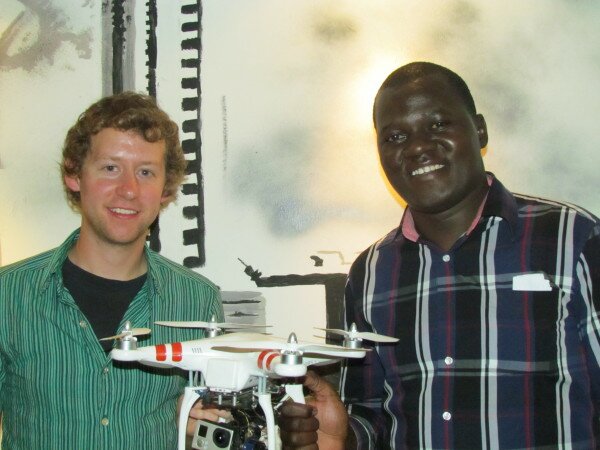
Ben Kreimer and Dickens Olewe showing off a drone
African SkyCAM has launched in Nairobi, Kenya, establishing Africa’s first newsroom-based “eye in the sky” drones and camera-equipped balloons to allow journalists to cover breaking news in dangerous or remote areas without the need for costly helicopters.
Speaking to a gathering of journalists, technologists, researchers and activists at the 88mph garage in Nairobi for a HacksHackers event, Dickens Olewe, a journalist at Star Publications and founder of African SkyCAM, said the concept was born when he was working on a piece about flooding at Lake Nakuru.
“I was convinced broadcast coverage could be much richer with holistic coverage using drones,” he Olewe, saying the resultant piece gave a better perspective to the park’s management and more context for news alerts.
Ben Kreimer, a journalism-technologist who works with the University of Nebraska-Lincoln’s Drone Journalism Lab, and also a keynote speaker at the event, said the game-changer is new perspectives and new experiences.
“Flying newsroom drones give holistic reporting and scale in crisis situations,” he said.
Kreimer said drone journalism would allow journalists to access areas they would not have ventured to under normal circumstances.
CCTV Africa is one media house embracing drone journalism in collaboration with the Olewe and Kreimer at Olpejeta Nature Park for the purposes of wildlife filming.
The University of Nairobi through its Fablab is also keen to include journalists in its Flying Donkey project, which uses drones to take supplies to people in times of crisis such as floods.
Regulations pose a challenge to the concept in some countries, though this is not the case in Kenya.
“Flying unmanned aerial vehicles (UAVs) has challenges. Some city laws are against it and the question is how do we get around that as media,” said Kreimer.
“I am glad to have been able to come to Kenya and other countries where drone journalism hasn’t been outlawed.”
Olewe said legislation was however necessary to protect the interests of those who seek to use the technology in meaningful ways that will impact citizens and journalism positively.
A case in point is an incident where a drone crashed on a Naivasha farm and the local police named it a “mysterious flying object”. Olewe said these flying drones – used recklessly or for illegal purposes such as surveillance on the public – could jeopardise whatever form of understanding that could be reached with the law.
“The aviation authority should licence flying of newsroom drones,” he said, but added the struggle is in the image presented by the name “drone” and the abilities of the technology itself. “The problem is that journalism should seek to “de-militise” the notion of drones.”
South Africa will be African SkyCAM’s next stop and Kreimer will be at the Johannesburg and Cape Town HacksHackers chapters to discuss the same issue.

















